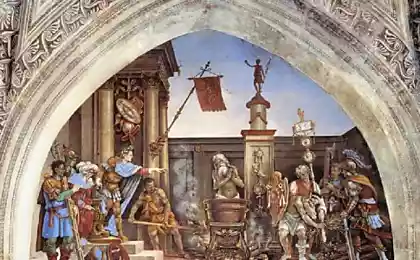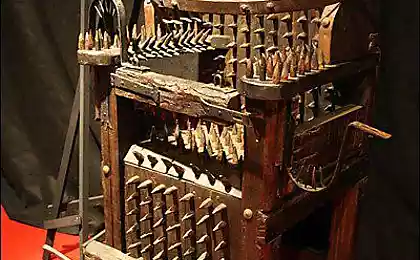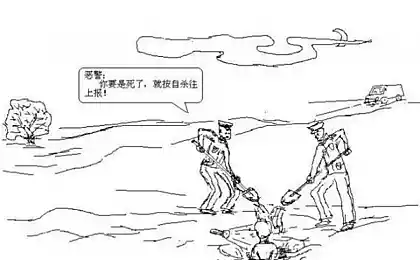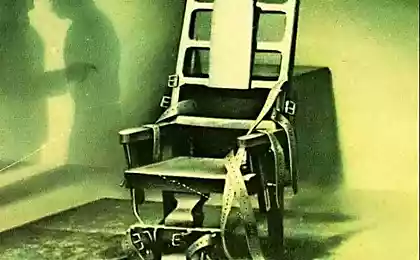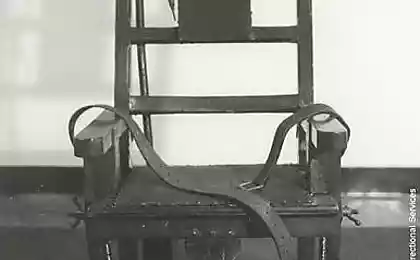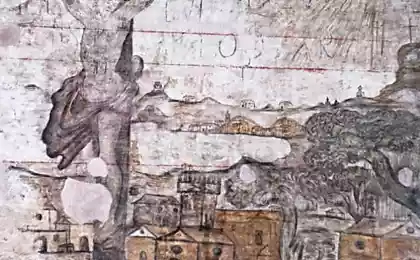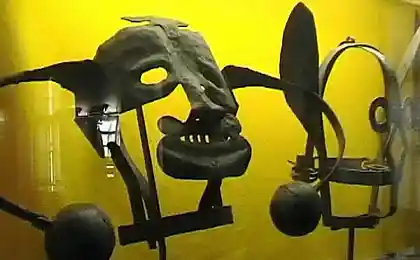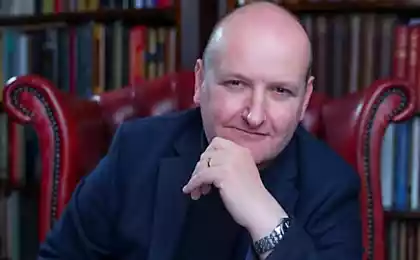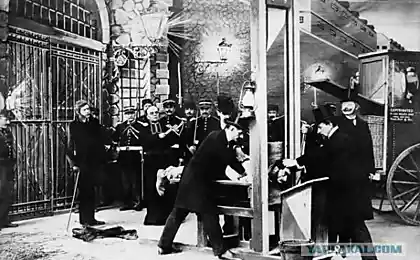1546
Torture and execution of witches in the Middle Ages
Torture in Witching process is highlighted, for only thanks to them that the witch hunters managed to squeeze out of those accused of mad recognition, which later had to serve as proof of religious fantasies of the Devil, a deal with demons and satanic charms.
The duration and severity of torture is determined solely by the judge. Article 58 minutes, "Carolina," ** says: "... whether to interrogation (ie tortured), depending on the suspicion, often, long or short, or too severely, the judge decides to entrust to the good and reasonable." Many inquisitors were not good and reasonable, as superstitious and fanatical people around who saw a threat to the Christian faith, and therefore with the utmost rigor pursued "Satanic Witch spawn."
The consequences for the accused were really awful.
After all, witchcraft was a crime exceptional, and because in most processes Witching torture was more severe and prolonged, and used many times. Accordingly great was the number of those who are in the hands of their tormentors faints, dies or commits suicide ...
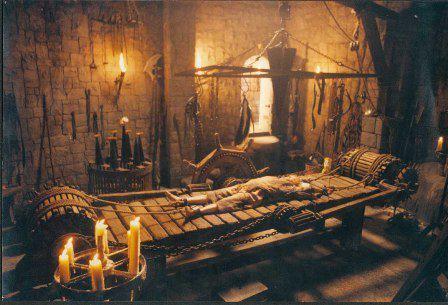
However, it is not, not only did not stop the fanatics of judges, but, on the contrary, it was considered another proof of malice of evil spirits. After all, they believe that those who have lost their senses under torture, were euthanized by the Devil, who decided to save them from questioning. Died under torture or commit suicide out of desperation were not victims of the court, and all those sacrifices Satan to take away their lives. Jesuit Friedrich Spee von Langenfeld (1591 - 1635) strongly denounced the judgment is madness. In his famous polemic treatise "Caution judges, or about Witching processes" (first published in Latin in 1631), he accused the inquisitors that they spawned so many witches. After all, no man can resist them under torture. Innocent more guilty than endure such torment. And bring them to experience such suffering, they, the pious prosecutors would recognize themselves witches. I would not like if they ever check it out? "Wish I test you, and then you got me - in wizards would have all of us." Better you can not specify the relationship of torture and obsession with witchcraft. As torture Witching processes commonly used in special squeezing fingers grip, overlay pads on their feet (torture of Spanish boots) or accused of torture on the rack.
The execution of the medieval "witches»
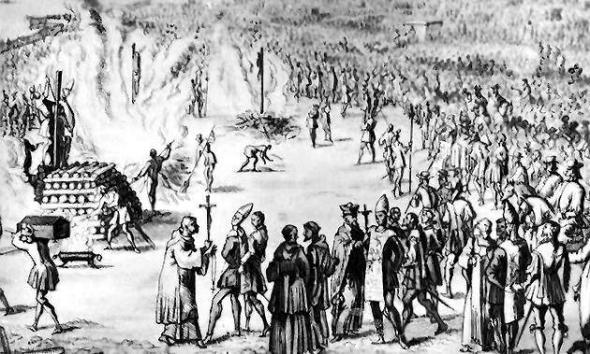
However, it is not, not only did not stop the fanatics of judges, but, on the contrary, it was considered another proof of malice of evil spirits. After all, they believe that those who have lost their senses under torture, were euthanized by the Devil, who decided to save them from questioning. Died under torture or commit suicide out of desperation were not victims of the court, and all those sacrifices Satan to take away their lives. Jesuit Friedrich Spee von Langenfeld (1591 - 1635) strongly denounced the judgment is madness. In his famous polemic treatise "Caution judges, or about Witching processes" (first published in Latin in 1631), he accused the inquisitors that they spawned so many witches. After all, no man can resist them under torture. Innocent more guilty than endure such torment. And bring them to experience such suffering, they, the pious prosecutors would recognize themselves witches. I would not like if they ever check it out? "Wish I test you, and then you got me - in wizards would have all of us." Better you can not specify the relationship of torture and obsession with witchcraft. As torture Witching processes commonly used in special squeezing fingers grip, overlay pads on their feet (torture of Spanish boots) or accused of torture on the rack.
Spanish boots.
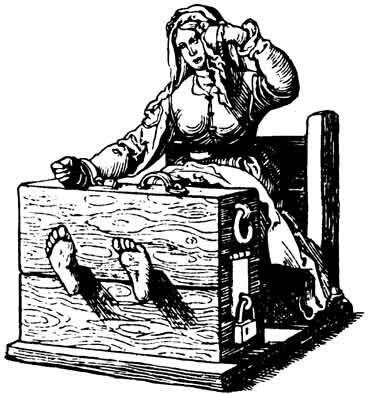
Basically torture on Witching processes did not differ from torture in conventional processes. However, they were more violent, lengthy and frequent. At the same time the men were stripped naked to the waist, or, as the women clothed in a special roomy garment. Interrogation lasted for hours, and sometimes days. It began with the use of clutches, special metal devices in which the defendant is gradually squeezing the fingers, first alone and then together. If the accused stood this simple torture, the executioner put on his "Spanish boots" - bent metal plate or block, that from one question to be tightening under the shin. Anyone who continued to insist on his innocence, tied his hands and vzdergivali on the rack - a method that could be tightened by suspending the body accused of various cargoes. No less painful was the forced extension of the body with the help of a rope hoists - the so-called "stretching". Jesuit Friedrich Spee von Langenfeld (1591 - 1635)
The execution of the witch Anne Hendricks, who burned to death in 1571 in Amsterdam. An engraving by the Dutch artist and poet Jan Lyukeyna shows the inhumanity and brutality of prosecutors, who did not know pity for "maidens exposing the Devil."
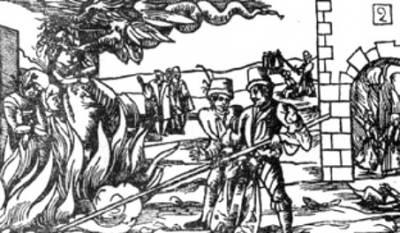
In addition to the "usual" torture judges could use other means. What, then, did the accused torturer what sophisticated methods applied it, torturing their victims in front of the judges and clerks, sat impassively beside or send as essence of the case, have a snack - this we do not talk. Suffice it to say that the participants of the procedure used by any means, in order to compel the accused to speak, and there was no mercy for anyone, either children or the elderly. Knowing self-righteous judges, it is difficult to imagine that there are people withstood interrogation and nothing had confessed. However, the benefits of this, they still would have been a little bit. After all, the torturers have enough imagination to recognize in any case they have been guilty. Those few who managed to survive the torture and escape to freedom, were for life maimed or mentally ill.
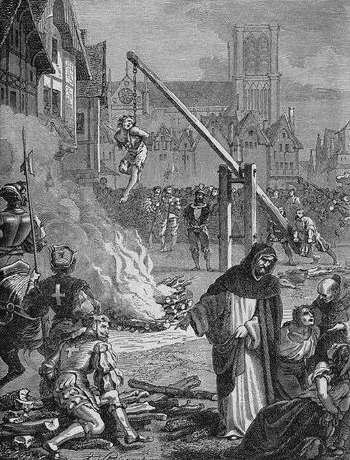
At the height of the witch hunt, most processes are finished a death sentence. However, the number of executions in different ways depending on the time and place of the processes. Sometimes, only a few managed to be released after interrogation and torture. Who will manage to break free? There are three groups of people whose fate was different. Some court released before sentencing because of illness or physical infirmity. They fall into the poorhouse or shelters for the terminally ill, where them were closely monitored.
The other group consisted of men and women who make excuses for lack of evidence. But they gained freedom was illusory, because at the slightest suspicion they could be re-grab, tortured and maybe executed. Despite the release, they had to comply with strict requirements. Family holidays and public spectacle of them were excluded. Many people had to live in a kind of retreat, as to leave his home and yard it was forbidden.
The third group belonged liberated those who were driven from their homes. For them, especially for women, the expulsion was often tantamount to a death sentence deferred. The poor and despised, they have gone abroad, drove them everywhere and showered curses. They fell and ended his life somewhere in the dirt and poverty. However, the expulsion of the sentence was mild enough, if we recall the fate of those who are destined to be at the end of the brutal torture to accept painful death. Happiness happen to them if "the prince's grace" of their pre-asphyxiating or decapitated. Usually witches were burned alive as required Article 109-I "Carolina": "Anyone divination inflict harm his people and losses of punishment should be death, and the punishment must be served by fire».
This engraving shows the burning of Jan Lyukeyna 18 witches and wizards in Salzburg in 1528.
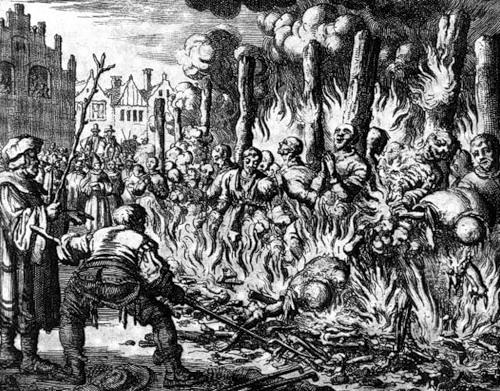
This shows that the church sought the witch hunters from "the accursed devil's spawn," there should be no trace, nothing but ashes scattered by the winds.
Image
The burning of witches was a public spectacle, the main purpose of which was to warn and frighten onlookers. From afar, people flocked to the place of execution. Festively dressed, gathered representatives of the local authorities: the bishop, canons and priests, the mayor and members of the Town Hall, judges and judicial assessors. Finally, accompanied by the hangman on trolleys brought bound witches and wizards. A trip to the penalty has been an ordeal, because the onlookers did not miss the opportunity to laugh and make fun of the convicted witches, making his last journey. When accidents finally get to the place of execution, their servants chained to poles with chains and surrounded by dry firewood, logs and straw. Then began a solemn ritual, during which the preacher again warned the people from oppression of the Devil and his minions. Then the executioner brought a torch to the fire. When the officials were going home, the servants continued to keep the fire as long as from the "witch's fire" is not left alone ashes. Executioner carefully shoveled it and then scattered at the scaffold or in any other place, in order to remain nothing more reminiscent of blasphemous deeds executed accomplices of the Devil.
In October 1517 the monk Martin Luther (1483 - 1546) was made in the University of Wittenberg with his 95 theses against indulgences. The envoys of the Pope claimed that by paying money for the indulgence, after the death of the believer can shorten their stay in purgatory. This so-called "dispute of indulgences" marked the beginning of the Reformation, that is, transformation of Christian doctrine, taken by Luther and subsequently led to the departure of its adherents, Protestants from the Roman Catholic Church and the papacy. Today the word "reformation" reminds us of the victory of reason over the obscurantism of the Middle Ages and the release: the release of obsolete dogmas and practices of the stagnant way of thinking. Indeed, the Reformation has had a huge impact on many areas of life. However, demonology is not one of them. Here Luther was committed to the old delusions. However, some of them caused him doubt, for example, the Sabbath, and flying witches. But the existence of a deal with the devil, magical damage he had no doubt.

Martin Luther.
"Sorcerers and witches - he wrote in 1522 - the essence of evil devilish offspring, they steal the milk, bring on bad weather, inflicts damage on people, strength in his legs taken away, tortured children in the cradle ... urge people to love and copulation, and carry the machinations of the Devil. " Luther was a supporter of severe punishment for witches and wizards, following, like their Catholic opponents, the Old Testament: "witch shall save alive" (Ex. 22, 18). As if in confirmation, in 1540 in Wittenberg, "the capital of the Reformation," brutally burned witches and sorcerers three. After the death of Luther in the Protestant areas of Germany are mad witch-hunters as well as in land remaining Catholic. Some reformers even revered witch hunt masters of sacred duty to God. Thus, in the Lutheran Electorate of Saxony and the Palatinate, and the Duchy of Württemberg in 1567 -1582 years. there own laws about witches, much more severe than the corresponding article «Carolina».
- ** Carolina - adopted in 1532 and published in 1533. Criminal
judicial Code of the "Holy Roman Empire of the German nation." I got
named in honor of Emperor Charles V (1519 - 1555). As the only
empire-wide laws fragmented Germany, Carolina was aimed
organize criminal proceedings in local courts. The first part of it
devoted to the stages of the criminal process; second - in the role of criminal acts
Code.
via judasprist
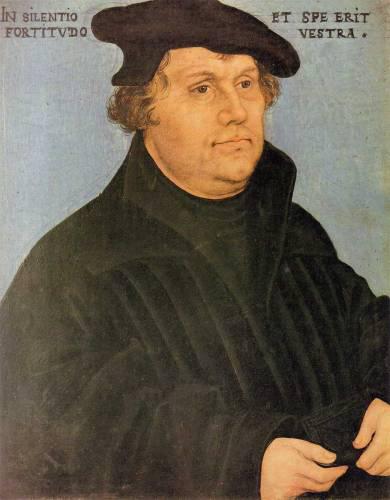
Source:
The duration and severity of torture is determined solely by the judge. Article 58 minutes, "Carolina," ** says: "... whether to interrogation (ie tortured), depending on the suspicion, often, long or short, or too severely, the judge decides to entrust to the good and reasonable." Many inquisitors were not good and reasonable, as superstitious and fanatical people around who saw a threat to the Christian faith, and therefore with the utmost rigor pursued "Satanic Witch spawn."
The consequences for the accused were really awful.
After all, witchcraft was a crime exceptional, and because in most processes Witching torture was more severe and prolonged, and used many times. Accordingly great was the number of those who are in the hands of their tormentors faints, dies or commits suicide ...

However, it is not, not only did not stop the fanatics of judges, but, on the contrary, it was considered another proof of malice of evil spirits. After all, they believe that those who have lost their senses under torture, were euthanized by the Devil, who decided to save them from questioning. Died under torture or commit suicide out of desperation were not victims of the court, and all those sacrifices Satan to take away their lives. Jesuit Friedrich Spee von Langenfeld (1591 - 1635) strongly denounced the judgment is madness. In his famous polemic treatise "Caution judges, or about Witching processes" (first published in Latin in 1631), he accused the inquisitors that they spawned so many witches. After all, no man can resist them under torture. Innocent more guilty than endure such torment. And bring them to experience such suffering, they, the pious prosecutors would recognize themselves witches. I would not like if they ever check it out? "Wish I test you, and then you got me - in wizards would have all of us." Better you can not specify the relationship of torture and obsession with witchcraft. As torture Witching processes commonly used in special squeezing fingers grip, overlay pads on their feet (torture of Spanish boots) or accused of torture on the rack.
The execution of the medieval "witches»

However, it is not, not only did not stop the fanatics of judges, but, on the contrary, it was considered another proof of malice of evil spirits. After all, they believe that those who have lost their senses under torture, were euthanized by the Devil, who decided to save them from questioning. Died under torture or commit suicide out of desperation were not victims of the court, and all those sacrifices Satan to take away their lives. Jesuit Friedrich Spee von Langenfeld (1591 - 1635) strongly denounced the judgment is madness. In his famous polemic treatise "Caution judges, or about Witching processes" (first published in Latin in 1631), he accused the inquisitors that they spawned so many witches. After all, no man can resist them under torture. Innocent more guilty than endure such torment. And bring them to experience such suffering, they, the pious prosecutors would recognize themselves witches. I would not like if they ever check it out? "Wish I test you, and then you got me - in wizards would have all of us." Better you can not specify the relationship of torture and obsession with witchcraft. As torture Witching processes commonly used in special squeezing fingers grip, overlay pads on their feet (torture of Spanish boots) or accused of torture on the rack.
Spanish boots.

Basically torture on Witching processes did not differ from torture in conventional processes. However, they were more violent, lengthy and frequent. At the same time the men were stripped naked to the waist, or, as the women clothed in a special roomy garment. Interrogation lasted for hours, and sometimes days. It began with the use of clutches, special metal devices in which the defendant is gradually squeezing the fingers, first alone and then together. If the accused stood this simple torture, the executioner put on his "Spanish boots" - bent metal plate or block, that from one question to be tightening under the shin. Anyone who continued to insist on his innocence, tied his hands and vzdergivali on the rack - a method that could be tightened by suspending the body accused of various cargoes. No less painful was the forced extension of the body with the help of a rope hoists - the so-called "stretching". Jesuit Friedrich Spee von Langenfeld (1591 - 1635)
The execution of the witch Anne Hendricks, who burned to death in 1571 in Amsterdam. An engraving by the Dutch artist and poet Jan Lyukeyna shows the inhumanity and brutality of prosecutors, who did not know pity for "maidens exposing the Devil."

In addition to the "usual" torture judges could use other means. What, then, did the accused torturer what sophisticated methods applied it, torturing their victims in front of the judges and clerks, sat impassively beside or send as essence of the case, have a snack - this we do not talk. Suffice it to say that the participants of the procedure used by any means, in order to compel the accused to speak, and there was no mercy for anyone, either children or the elderly. Knowing self-righteous judges, it is difficult to imagine that there are people withstood interrogation and nothing had confessed. However, the benefits of this, they still would have been a little bit. After all, the torturers have enough imagination to recognize in any case they have been guilty. Those few who managed to survive the torture and escape to freedom, were for life maimed or mentally ill.

At the height of the witch hunt, most processes are finished a death sentence. However, the number of executions in different ways depending on the time and place of the processes. Sometimes, only a few managed to be released after interrogation and torture. Who will manage to break free? There are three groups of people whose fate was different. Some court released before sentencing because of illness or physical infirmity. They fall into the poorhouse or shelters for the terminally ill, where them were closely monitored.
The other group consisted of men and women who make excuses for lack of evidence. But they gained freedom was illusory, because at the slightest suspicion they could be re-grab, tortured and maybe executed. Despite the release, they had to comply with strict requirements. Family holidays and public spectacle of them were excluded. Many people had to live in a kind of retreat, as to leave his home and yard it was forbidden.
The third group belonged liberated those who were driven from their homes. For them, especially for women, the expulsion was often tantamount to a death sentence deferred. The poor and despised, they have gone abroad, drove them everywhere and showered curses. They fell and ended his life somewhere in the dirt and poverty. However, the expulsion of the sentence was mild enough, if we recall the fate of those who are destined to be at the end of the brutal torture to accept painful death. Happiness happen to them if "the prince's grace" of their pre-asphyxiating or decapitated. Usually witches were burned alive as required Article 109-I "Carolina": "Anyone divination inflict harm his people and losses of punishment should be death, and the punishment must be served by fire».
This engraving shows the burning of Jan Lyukeyna 18 witches and wizards in Salzburg in 1528.

This shows that the church sought the witch hunters from "the accursed devil's spawn," there should be no trace, nothing but ashes scattered by the winds.
Image
The burning of witches was a public spectacle, the main purpose of which was to warn and frighten onlookers. From afar, people flocked to the place of execution. Festively dressed, gathered representatives of the local authorities: the bishop, canons and priests, the mayor and members of the Town Hall, judges and judicial assessors. Finally, accompanied by the hangman on trolleys brought bound witches and wizards. A trip to the penalty has been an ordeal, because the onlookers did not miss the opportunity to laugh and make fun of the convicted witches, making his last journey. When accidents finally get to the place of execution, their servants chained to poles with chains and surrounded by dry firewood, logs and straw. Then began a solemn ritual, during which the preacher again warned the people from oppression of the Devil and his minions. Then the executioner brought a torch to the fire. When the officials were going home, the servants continued to keep the fire as long as from the "witch's fire" is not left alone ashes. Executioner carefully shoveled it and then scattered at the scaffold or in any other place, in order to remain nothing more reminiscent of blasphemous deeds executed accomplices of the Devil.
In October 1517 the monk Martin Luther (1483 - 1546) was made in the University of Wittenberg with his 95 theses against indulgences. The envoys of the Pope claimed that by paying money for the indulgence, after the death of the believer can shorten their stay in purgatory. This so-called "dispute of indulgences" marked the beginning of the Reformation, that is, transformation of Christian doctrine, taken by Luther and subsequently led to the departure of its adherents, Protestants from the Roman Catholic Church and the papacy. Today the word "reformation" reminds us of the victory of reason over the obscurantism of the Middle Ages and the release: the release of obsolete dogmas and practices of the stagnant way of thinking. Indeed, the Reformation has had a huge impact on many areas of life. However, demonology is not one of them. Here Luther was committed to the old delusions. However, some of them caused him doubt, for example, the Sabbath, and flying witches. But the existence of a deal with the devil, magical damage he had no doubt.

Martin Luther.
"Sorcerers and witches - he wrote in 1522 - the essence of evil devilish offspring, they steal the milk, bring on bad weather, inflicts damage on people, strength in his legs taken away, tortured children in the cradle ... urge people to love and copulation, and carry the machinations of the Devil. " Luther was a supporter of severe punishment for witches and wizards, following, like their Catholic opponents, the Old Testament: "witch shall save alive" (Ex. 22, 18). As if in confirmation, in 1540 in Wittenberg, "the capital of the Reformation," brutally burned witches and sorcerers three. After the death of Luther in the Protestant areas of Germany are mad witch-hunters as well as in land remaining Catholic. Some reformers even revered witch hunt masters of sacred duty to God. Thus, in the Lutheran Electorate of Saxony and the Palatinate, and the Duchy of Württemberg in 1567 -1582 years. there own laws about witches, much more severe than the corresponding article «Carolina».
- ** Carolina - adopted in 1532 and published in 1533. Criminal
judicial Code of the "Holy Roman Empire of the German nation." I got
named in honor of Emperor Charles V (1519 - 1555). As the only
empire-wide laws fragmented Germany, Carolina was aimed
organize criminal proceedings in local courts. The first part of it
devoted to the stages of the criminal process; second - in the role of criminal acts
Code.
via judasprist

Source:



